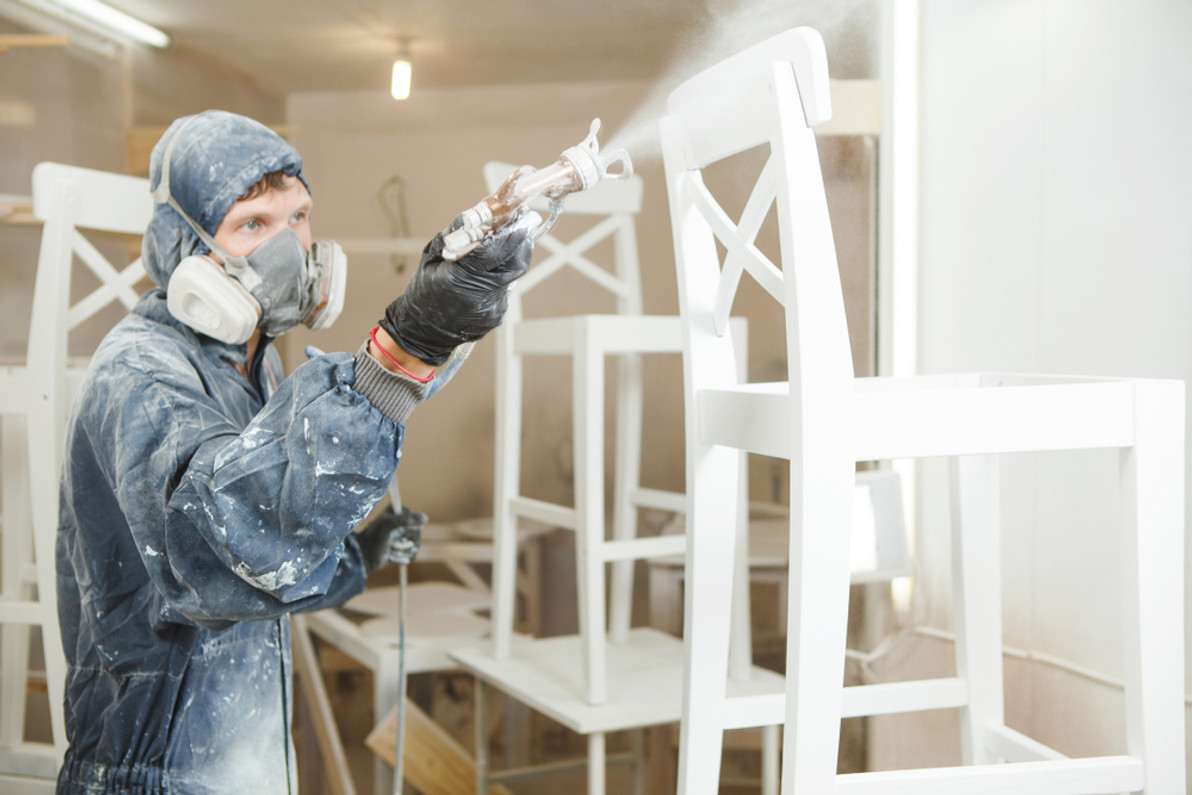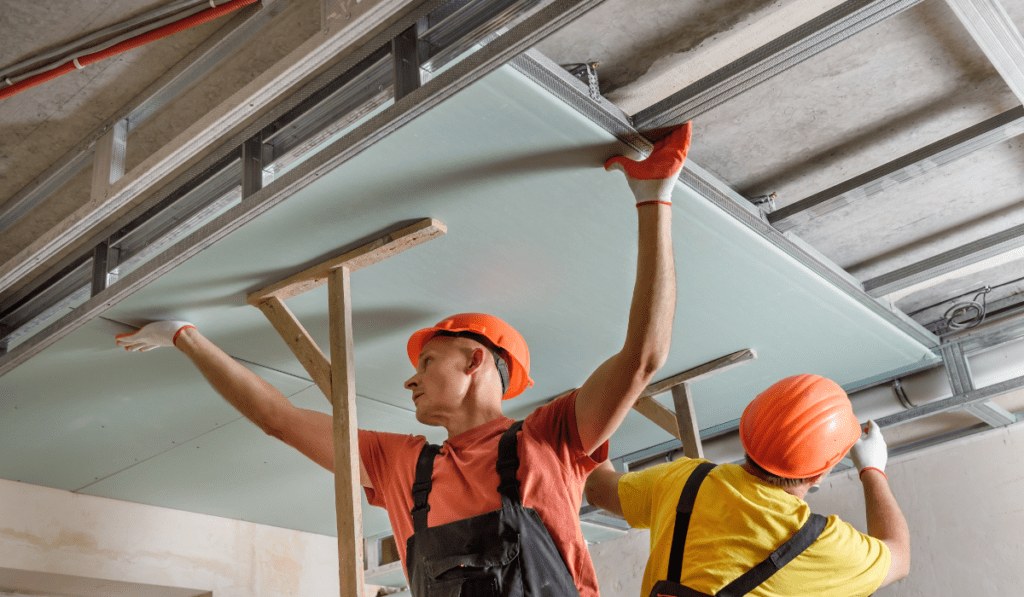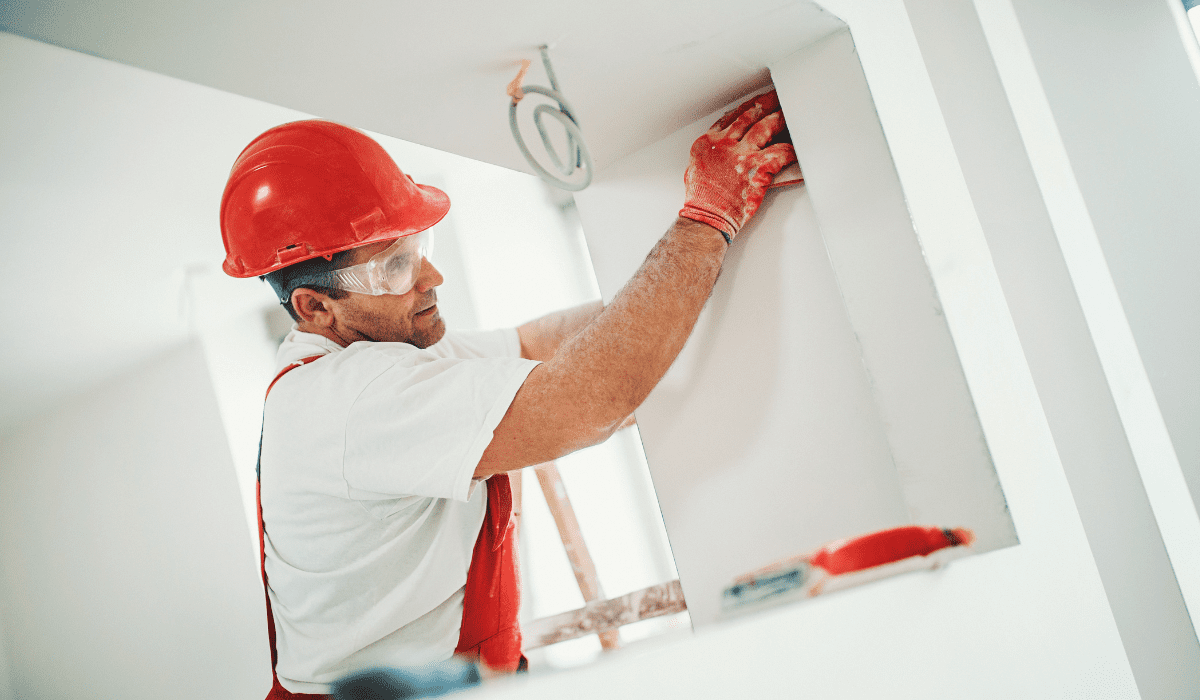To fireproof drywall, apply fire-resistant compounds or use Type X drywall, which is specifically designed for fire resistance. Always choose materials that meet the required fire codes and standards for your specific application.
Fireproofing drywall is a crucial step in enhancing the fire-resistance of both residential and commercial structures. By either using specialized drywall known as Type X, which incorporates non-combustible fibers, or by treating standard drywall with fire-retardant sprays and paints, builders and homeowners can significantly increase the time it takes for a fire to spread.
This process not only helps in safeguarding the property and its occupants but also complies with building regulations, which often mandate a certain level of fire resistance. Effective fireproofing of drywall contributes to a comprehensive safety plan, reducing the risk of fire-related accidents and ensuring peace of mind.

Introduction To Fireproof Drywall
Safety in our homes and workplaces is crucial. Fireproof drywall is a key material to consider. It helps to protect structures from fire. In this section, we delve deeper into why fireproof drywall is essential. We learn how it works. Our goal is to understand fire-resistant construction better. We’ll also explore the basics of drywall as a building material.
Importance Of Fire-resistant Construction
Safety is not a choice; it’s a necessity. Buildings must withstand fire hazards. Lives and property rely on fire-resistant materials. Fireproof drywall plays a big role. It slows down fires. This extra time is critical. It can save lives. It allows safe evacuation. And, it minimizes damage.
- Protects structures and occupants.
- Gives more time to escape during a fire.
- Limits the damage to a building.
Basics Of Drywall As A Building Material
Drywall is also known as gypsum board. It’s popular in modern construction. It’s made by placing gypsum between paper layers. It’s easy to install. It’s also cost-effective. But not all drywall resists fire.
| Type | Features | Use |
|---|---|---|
| Regular Drywall | Easy installation | General walls and ceilings |
| Fireproof Drywall | Contains fire-resistant materials | Areas needing extra fire protection |
Fireproof drywall contains fiberglass. It is made to withstand high temperatures. It can protect for up to four hours.
Types Of Fire-resistant Drywall
Exploring the world of drywall might seem straightforward until you encounter its fire-resistant variants. Fire-resistant drywall is a must for ensuring the safety of structures and their occupants. Let’s dive into the types of fireproof drywall and understand which works best for which situation.
Standard Vs. Type X Vs. Type C
Selecting the right type of fire-resistant drywall is crucial for safety. Each type has its unique composition and fire-rating. Here’s a breakdown:
- Standard Drywall: Offers a basic level of protection and is suitable for non-fire rated applications.
- Type X Drywall: Contains glass fibers, boosting its fire resistance. Type X is thicker than standard and can resist fire for up to one hour.
- Type C Drywall: Similar to Type X but with enhanced fire resistive materials and properties. Type C is designed to withstand fire for even longer periods.
Understanding The Fire Rating System
The fire rating of drywall indicates how long it can withstand a fire. This rating is governed by ASTM standards. See the simplified fire rating system:
| Material | Thickness | Fire Rating |
|---|---|---|
| Standard Drywall | 1/2 inch | 30 minutes |
| Type X Drywall | 5/8 inch | 1 hour |
| Type C Drywall | 5/8 inch or more | 1-4 hours |
Fireproofing At The Installation Stage
Keeping your home safe is crucial. A big part of that is fireproofing drywall during installation. This means you make it resist fire right from the start. It’s like giving your walls a shield against fire!
Best Practices In Drywall Installation
To make sure drywall stands up to fire, follow these tips:
- Use Type X drywall: It’s thicker and has special fibers that resist fire.
- Seal gaps: Use fire-resistant caulk to fill spaces where walls meet.
- Proper joint taping: Tape all seams well to stop fire from sneaking through.
- Use screws, not nails: Nails can pop out in a fire. Screws stay put.
- Choose the right thickness: Thicker drywall is often better against fire.
Critical Points In Commercial And Residential Buildings
It’s key to focus on places that matter most:
| Area | Importance | Fireproofing Action |
|---|---|---|
| Walls separating units | Keep fire in one place | Use double layers of Type X drywall |
| Floors/Ceilings | Stop fire moving up or down | Install fire-rated ceiling assemblies |
| Shafts for pipes and ducts | Weak spots for fire spread | Use shaft wall systems |
| Exits and corridors | Safe paths to get out | Protect with additional fire-resistant boards |
Essential Fireproofing Materials

Protecting your home from fire starts with the right materials. Drywall can offer some protection. Yet, it can’t do it alone. The secret comes down to the essential fireproofing materials used during installation. Adding these to drywall turns it into a strong barrier. Interior walls and ceilings will be much safer.
Fire-resistant Compounds And Tapes
Fire-resistant compounds and tapes are top choices for fireproofing. These materials are key when installing drywall. They help to seal joints and cracks. This limits the spread of flames. Let’s look at what they include:
- Joint compound: This is also known as mud. It fills and seals joints between drywall sheets.
- Fire-rated drywall tape: This works with the joint compound. It bridges gaps for a smoother finish.
- Fire caulk: Use this to seal small openings around wires or pipes. It prevents fire from spreading.
Choosing The Right Jointing And Finishing Materials
To ensure safety, pick the right products. Your choices will affect how well your walls resist fire. Here’s a guide:
| Material | Use | Fire Rating |
|---|---|---|
| Type X Drywall | Walls and Ceilings | High |
| Fire-Resistant Joint Compound | Sealing Joints | Varies |
| Intumescent Sealant | Sealing Gaps | High |
Always look for certified materials. Choose products with a high fire rating. Labels often show these ratings. They tell you how long the product can stand against fire. More minutes mean better protection.
Improving Existing Drywall Fire Resistance
Safety Compliance And Regulations
When talking about fireproofing drywall, safety is paramount. Local building codes and certification standards must guide installation. Installing fireproof drywall correctly can save lives and properties. Here’s how to comply with safety regulations.
Adhering To Local Building Codes
Local building codes set minimum safety standards. These codes include specific requirements for drywall’s fire resistance. Check local codes before starting.
- Identify local fire safety criteria.
- Select drywall with the right fire rating.
- Follow installation guidelines strictly.
Work with a professional for compliance assurance. They understand local codes and can help meet them.
Certification And Testing For Fireproof Drywall
Manufacturers test fireproof drywall for safety. Labs issue certifications after successful tests. Use certified drywall to ensure safety.
Certified drywall has:
| Type | Fire Rating | Uses |
|---|---|---|
| Type X | 1 Hour | Walls, Ceilings |
| Type C | 2-4 Hours | More Protection Areas |
Look for the product label or stamp which proves testing and certification compliance.
Professional Installation Vs. Diy
Deciding between professional installation and tackling a DIY project comes with its own set of considerations, especially when fireproofing drywall is on the agenda. Discover the best route for you by understanding the intricacies and challenges involved in both approaches.
When To Call In The Professionals
Fireproofing drywall requires precision and knowledge of building codes. For large projects, complex structures, or when safety is a primary concern, it’s crucial to hire a professional. Consider these scenarios where expert help is essential:
- Spaces over a certain size or height
- Requirements for a specific fire rating
- Installation around hazardous equipment
- Limited experience with construction
- Navigating permits and inspections
Tips For The Diy Approach
If you choose the DIY path for installing fireproof drywall, take these tips to heart. They will help ensure a safe and effective installation:
- Choose the right type of drywall.
- Measure and cut precisely.
- Apply fire-resistant compounds correctly.
- Seal all joints and edges thoroughly.
- Consult local fire codes for guidance.
Regular checkups and maintenance will keep your installation up to code and functioning effectively. Be diligent and take your time to ensure the best results.

Credit: www.lowes.com
Maintaining Fireproof Drywall
Keeping your fireproof drywall in top condition is crucial. It ensures the safety of your building. Proper maintenance can extend its lifespan and efficiency. Regular check-ups and timely repairs are key. Let’s dive into how to maintain your fireproof drywall effectively.
Regular Inspections And Upkeep
Regular inspections can spot potential issues early. They prevent bigger problems. Follow these simple steps:
- Check for cracks or damage every few months.
- Look out for signs of moisture or mold.
- Ensure joints and edges are sealed properly.
Keep a record of your inspections. It helps track the wall’s condition.
Addressing Wear And Tear Over Time
Drywall can wear down over time. It’s important to address this. Here’s what to do:
- Fill in minor cracks with fire-rated compounds.
- Replace sections that have serious damage.
- Paint with fire-resistant paint if the coat wears off.
This upkeep maintains the wall’s fire-resistance. Don’t overlook repairs. Act promptly on any damage.
Frequently Asked Questions On How Do You Fireproof Drywall?
Can Drywall Be Fire-resistant?
Regular drywall isn’t inherently fireproof, but Type X drywall has fire-resistant properties due to added non-combustible fibers.
What Makes Drywall Fireproof?
Type X drywall contains gypsum fortified with glass fibers, increasing its resistance to fire exposure significantly.
How To Install Fire-rated Drywall?
Fire-rated drywall is installed similarly to regular drywall, ensuring joints are tightly fitted and seams are properly taped and mudded.
Is Fireproof Drywall Required By Code?
In certain areas of a building, like between an attached garage and living space, fire codes often require the use of fire-resistant drywall.
Difference Between Type X And Type C Drywall?
Type X drywall is fire-rated for one hour, while Type C offers enhanced fire-resistance and is rated for up to four hours.
How To Identify Fire-rated Drywall?
Fire-rated drywall typically has a distinct color-coded paper facing and is stamped with a fire-rating label for easy identification.
Conclusion
Fireproofing drywall is crucial for enhancing home safety. By selecting the right materials and applying proper techniques, homeowners can successfully boost their walls’ resistance to fire. Always remember, safety is paramount. Regular upgrades and adherence to building codes can make a significant difference.
Protect your space effectively with fire-resistant drywall solutions.

I’m Abdus Sobur, a highly skilled and professional Fire Safety Officer with a passion for safeguarding lives and property. Over the course of my career, I’ve conducted numerous successful fire safety audits, earning a reputation for excellence in ensuring public safety.
In addition to my role as a Fire Safety Officer, I’m also dedicated to raising awareness about the importance of fire safety. Through my blog, I share insights into the functions of different fire safety equipment, aiming to empower individuals with the knowledge they need to protect themselves and their communities.
I’m driven by a deep commitment to promoting fire safety awareness and preventing fire-related incidents.

